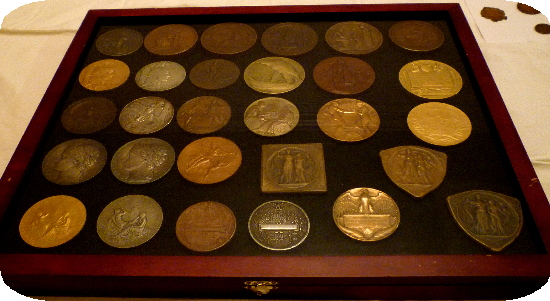Exposition officials rewarded participants and exhibit winners with elaborately engraved commemorative certificates, diplomas, or award medals. These exposition award medals were big and beautifully designed works of art, like art medals.
They were executed upon a design prepared under the Departments of Fine Art. The awards in every grade were publicly announced and were certified by diplomas at the end of each exposition but were delivered within 6 months to 2 years (Chicago) after the conclusion of the expositions.
They were awarded to participants on many levels including grand price, gold, silver and bronze. Award medals are often inscribed to recipients, in effect creating a unique medal. The medals were made many times of bronze metal. Bronze medals were supplied without charge by the authorities of the exhibition, but because of the costliness of the silver and gold medals, the recipients were expected in many cases to pay for them. Sometimes the silver or gold medal recipients had medals silver plated or gold plated.
These award medals were a big deal. They were chosen from hundreds and many times thousands of US and foreign exhibitors. Medal award winners took pride and general satisfaction in their awards. They often printed a copy of their medal on their flyers and advertising media if they had a commercial product. Ebay often has copies of medals for Jack Daniel’s, Eastside Beer and others. Also some bronze medal winners would gold plate their award medal.
The 1904 St. Louis expo medals
These are some of the most popular and collectable of all exposition medals. They are interesting because of their unique shapes and design, the unique material they are made of, and 5 levels of medals awarded. The exposition itself was popular and interesting also. 1904 expo medals were issued for grand prize, gold medal, silver medal, bronze medal, and commemorative medal, but all were made of the new bronze alloy, which was at first called “government bronze.” The inscriptions on the tablets noting the award as “gold medal,” “silver medal,” etc. are merely descriptive and do not refer to the type of metal used. However the various award medals had different overall shapes, but common central designs and are some of the most beautiful medals. lovely bronze metal. The 1904 expo award medals were designed by Adolph A. Weinman (who later designed the Walking Liberty Half Dollar and Mercury Dime), as one of his earliest commissions for a struck medal. The engravings and medals were struck by the U.S. mint in Philadelphia. Europeans especially view this medal collectible as an American medal.
The 1893 Saint Gaudens’ award medal
is considered by many as one of the most beautiful exposition award medals. It is included in the book 100 Greatest Medals.
The award medal of the 1902 South Carolina Inter-State and Indian Expo
while coming from a smaller expo, in our opinion this is one of the most beautiful award medals were ever acquired for our collection.
Every exposition had their Commission of Awards who selected for each department specialists of eminence in their respective pursuits. Most of them were men of national reputation and a number were recognized as authorities both in the US and Europe. There gentlemen were invited to serve on the Board of Awards without compensation, and almost all of them accepted. Sometimes foreign exhibitors asked for and receive “international” juries to pass upon their exhibits.
The awards were not made by individual judges, but by juries distributed into different sections, according to classifications based on departments of the exhibition. Typical departments were Minerals and Forestry, Agriculture, Food and Accessories, Machinery and Appliances, Horticulture, Machinery, Manufactures, Electricity, Fine Arts, Painting and Sculpture, Liberal Arts, Education, Literature.
Many award medals were large 2-inch or larger medals. Gorham Company first medals were for two New York City theaters (1876), then they did medals for five American Expositions from 1895 Cotton States, 1901-1902 South Carolina Inter-State and Indian Exposition, to 1909 Alaska-Yukon-Pacific.
There is no ‘Red Book of Medals’. Dealers and individuals sometimes sell a medal to a collector at a fraction of its worth. Or they sit on a medal they can’t sell for decades because they overpriced it. They just don’t know how to price medals correctly. An informed collector can purchased wisely building value in their medal collections.

Expo Medals Home 1853 1876 1893 1895 1897 1901
1901-1902 1904 1907 1909 1915 1939
also 1881 1883 1887 1898
Favorite Links For Collecting Medals. Some are for reference and some are dealers. The medal dealers sometimes have a better price than buying on Ebay.
Medal Collectors
E-Sylum
Expo Medals
So Called Dollars
So-calleddollars.com
Numismagram
The History Bank Store